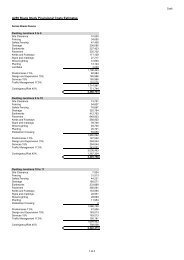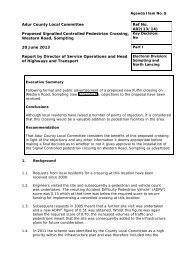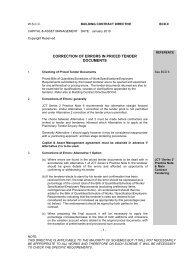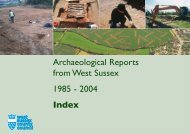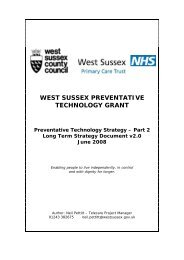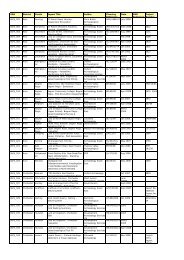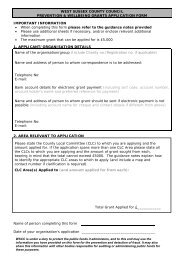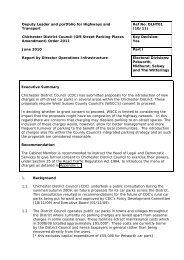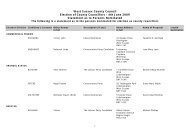Working together for a better future Working together for a better future
Working together for a better future Working together for a better future
Working together for a better future Working together for a better future
Create successful ePaper yourself
Turn your PDF publications into a flip-book with our unique Google optimized e-Paper software.
<strong>Working</strong><br />
<strong>together</strong> <strong>for</strong><br />
a <strong>better</strong> <strong>future</strong><br />
The Sustainable<br />
Community Strategy<br />
<strong>for</strong> West Sussex<br />
2008 - 2020
West Sussex Strategic Partnership is comprised of public, private,<br />
business and voluntary sector organisations working <strong>together</strong> <strong>for</strong> the<br />
benefit of West Sussex, its residents and visitors. All levels of local<br />
government are represented within the partnership through the<br />
county, district, borough, parish and town councils. The police, the<br />
Primary Care Trust and a wide range of service providers from the<br />
voluntary and statutory sectors are also represented.<br />
The Local Government and Public Involvement in Health Act 2007<br />
established the statutory framework <strong>for</strong> local partnerships to work<br />
<strong>together</strong> to improve the way communities access the services and<br />
opportunities they need in a sustainable way.<br />
The requirement was also established <strong>for</strong> county councils to take the<br />
lead within their partnerships in developing and agreeing the medium<br />
to long-term strategic vision <strong>for</strong> their county, their sustainable<br />
community strategy.<br />
This document is the sustainable community strategy agreed by the<br />
West Sussex Strategic Partnership.<br />
Introduction<br />
The West Sussex Strategic Partnership has reviewed<br />
the condition of the County and considered carefully<br />
what challenges and opportunities might lie ahead.<br />
Having consulted with individuals, businesses and<br />
communities, the Partnership sets out a shared<br />
vision <strong>for</strong> the County over the next ten years and<br />
beyond.<br />
This sustainable community strategy identifies what<br />
the key issues and priorities are across the<br />
whole range of services and what we<br />
would all like to see<br />
<strong>for</strong> West Sussex in the<br />
longer-term. This<br />
shared vision will focus<br />
the work of all service<br />
providers to meet<br />
the needs and<br />
aspirations of all:<br />
residents,<br />
communities,<br />
businesses and<br />
visitors.<br />
In some ways, the <strong>future</strong><br />
<strong>for</strong> West Sussex might<br />
not look as good as it may<br />
first appear. Pressures are<br />
increasing in many areas.<br />
So, what are the long-term challenges<br />
<strong>for</strong> West Sussex?<br />
●<br />
●<br />
Relative deprivation in some parts of the<br />
County is increasing. We need to ensure such<br />
areas are identified and the gap between the<br />
prosperous and the deprived is narrowed by<br />
bringing the standard of living up <strong>for</strong> those<br />
who are most deprived.<br />
West Sussex is one of the least af<strong>for</strong>dable<br />
parts of the country in which to buy a house.<br />
We need to ensure that good quality,<br />
sustainable and af<strong>for</strong>dable housing is built<br />
●<br />
where it is needed, while guarding against<br />
uncontrolled development in our beautiful and<br />
interesting countryside.<br />
There are more cars on the road than ever<br />
be<strong>for</strong>e and the networks are becoming<br />
strained. At the same time, climate change is<br />
<strong>for</strong>cing us to look at more sustainable options.<br />
Public transport is often very much needed to<br />
access services, but not by enough people to<br />
make it self-financing. Our challenge is to<br />
balance these pressures to provide the<br />
services that people want and need in the<br />
most sustainable ways while relieving the<br />
pressure on the road network.<br />
● Dealing with the<br />
challenges of migration<br />
requires proper planning<br />
to mitigate any risks to<br />
social cohesion and to<br />
harness the potential<br />
opportunities <strong>for</strong> the<br />
benefit of all.<br />
● Economic<br />
development in the<br />
County remains a<br />
key priority.<br />
Investment and<br />
regeneration is needed,<br />
particularly on the coast. We<br />
need <strong>better</strong> arterial transport<br />
links and a well-educated and<br />
trained work<strong>for</strong>ce to meet the<br />
needs of business.<br />
● We have an ageing population.<br />
Given the increasing pressures on the County, one<br />
thing that is certain to be a priority over the next<br />
ten or more years will be to get the most out of our<br />
resources. This will require all of us to play our part,<br />
residents, communities, organisations and businesses<br />
in closer partnership working across services and<br />
will be achieved best if resources are focussed on<br />
providing the framework <strong>for</strong> communities and<br />
individuals to help themselves.<br />
This is what sustainable communities are all about.<br />
2 3
Building cohesive communities<br />
and meeting diverse needs<br />
Sustainable communities are vibrant places where<br />
people want to live and<br />
comprise a range of factors<br />
including a high-quality<br />
natural and built<br />
environment, a varied and<br />
prosperous economy,<br />
availability of appropriate and<br />
af<strong>for</strong>dable housing, a just and<br />
inclusive society, a feeling of<br />
safety, a healthy population<br />
and access to services<br />
including culture and sports.<br />
The Partnership has a vital<br />
role to play in ensuring these<br />
factors can flourish even<br />
though, in financial terms, the<br />
<strong>future</strong> <strong>for</strong> West Sussex may<br />
not be as strong as it is at<br />
present.<br />
Pressures are increasing in<br />
every direction: housing,<br />
transport, the growing and<br />
ageing population, demands<br />
on the environment, climate<br />
change issues, sustaining a<br />
prosperous economy and<br />
providing decent jobs in the<br />
face of global competition.<br />
No matter how well the<br />
public agencies and other<br />
service providers per<strong>for</strong>ms<br />
public services are unlikely to<br />
improve as quickly as we<br />
might like <strong>for</strong> residents in<br />
West Sussex.<br />
It is there<strong>for</strong>e essential that<br />
public services in West<br />
Sussex work <strong>together</strong> in<br />
effective partnerships to create a bright <strong>future</strong> <strong>for</strong><br />
everyone in every community and build on the<br />
County’s successful inheritance.<br />
The Partnership sets out a vision that recognises the<br />
importance <strong>for</strong> people throughout West Sussex to<br />
be equipped with the in<strong>for</strong>mation, opportunities,<br />
options and support to allow them, as individuals and<br />
West Sussex<br />
pointers <strong>for</strong> action:<br />
The following headlines indicate the<br />
most important things that the<br />
Partnership will work to promote,<br />
foster change and improve:<br />
A <strong>better</strong> place to live<br />
Continue and renew ef<strong>for</strong>ts to<br />
mitigate and adapt to the effects of<br />
climate change<br />
Opportunity <strong>for</strong> all<br />
Maximise opportunities <strong>for</strong> achieving<br />
life-long learning and skills development<br />
to realise the potential in the work<strong>for</strong>ce<br />
Better health <strong>for</strong> all<br />
Tackle health inequalities and promote<br />
preventative approaches, especially<br />
in relation to common causes of<br />
premature death<br />
Staying and feeling safe<br />
Recognise the value of children and<br />
young people in society and increase<br />
community safety<br />
as communities, to influence decisions, take<br />
responsibility <strong>for</strong> their choices and access the<br />
services they want in ways that suit them best. Social<br />
inclusion and accommodating diversity bring with<br />
them the need <strong>for</strong> individuals<br />
and communities to take a<br />
measure of social<br />
responsibility.<br />
There is a need <strong>for</strong> people to<br />
share cultural experiences<br />
because this helps increase<br />
awareness of diversity, assists<br />
individuals in their<br />
understanding of others’<br />
needs and builds greater<br />
understanding.<br />
This sustainable community<br />
strategy is <strong>for</strong> the whole<br />
population; not just those who<br />
have traditionally been<br />
supported because they have<br />
the highest needs. Its aims are<br />
to:<br />
● build strong and cohesive<br />
communities where individuals<br />
feel included and recognise<br />
their responsibilities;<br />
● assist individuals and<br />
communities to access<br />
services and opportunities<br />
with minimal<br />
intervention; and,<br />
● encourage<br />
service providers<br />
to work as<br />
partners in<br />
focussing on<br />
the needs<br />
and<br />
aspirations<br />
of people, ensuring<br />
there are highquality,<br />
af<strong>for</strong>dable<br />
services and<br />
improving<br />
in<strong>for</strong>mation<br />
provision from a<br />
variety of sources, including through the<br />
internet, so people can identify and take<br />
opportunities and make choices.<br />
The success of this strategy will be the realisation of<br />
the vision it sets out. The Local Area Agreement is<br />
the short-term delivery vehicle <strong>for</strong> achieving the<br />
vision. Monitoring and review of the Agreement will<br />
provide an understanding of the per<strong>for</strong>mance of the<br />
strategy.<br />
Core themes of the strategy<br />
Work within the community, with<br />
elected Members, partners and<br />
stakeholders, along with analysis of<br />
existing strategies and programmes, has<br />
suggested that some issues are<br />
connected or interact in such a way to<br />
make it sensible to group them under<br />
a series of core themes. Four core<br />
themes have been identified and, in<br />
addition, a further principle was<br />
established relating to the need <strong>for</strong><br />
provision of services that meet diverse<br />
needs. The four core themes are<br />
explained below.<br />
Some issues that have been identified<br />
within a particular theme may be ‘crosscutting’<br />
in nature and could<br />
there<strong>for</strong>e equally ‘live’<br />
within one or more<br />
alternative themes.<br />
However, where<br />
possible such crosscutting<br />
issues have<br />
been located within<br />
the theme to<br />
which,<br />
consultation<br />
work has<br />
suggested, they<br />
have the<br />
greatest<br />
relevance.<br />
Bringing<br />
it all into<br />
focus...<br />
4<br />
5
A <strong>better</strong> place<br />
to live<br />
West Sussex is, <strong>for</strong> most<br />
people, a good place to<br />
live with a high-quality<br />
environment, effective<br />
services and<br />
opportunities. Access to<br />
parks, open spaces and nature are frequently cited by<br />
residents as being among the most important factors in<br />
making the County a good place to live. However,<br />
demands on our environment, both by human activity<br />
and by natural <strong>for</strong>ces, are increasing and we need to be<br />
prepared <strong>for</strong> the challenges that result. This strategy<br />
aims to ensure West Sussex becomes a <strong>better</strong> place to<br />
live <strong>for</strong> everyone. To achieve this, Partnership members,<br />
working effectively <strong>together</strong>, must address many<br />
challenges facing both the natural and man-made<br />
environments to ensure our communities, in their<br />
entirety, can benefit.<br />
Partners must work to achieve a County-wide sense<br />
of community. While striving <strong>for</strong> the highest standards<br />
in environmental protection, and where possible<br />
improvements, we must seek a balance with the<br />
inevitable pressure <strong>for</strong> continued growth to meet the<br />
demands of an expanding population. Below are some<br />
of the issues the Partnership will focus on in relation to<br />
this theme.<br />
Infrastructure, development and place shaping -<br />
creating clean, safe, attractive and accessible places <strong>for</strong><br />
people to live and work will require the delivery of<br />
appropriate physical and social infrastructure capacity<br />
to meet existing and planned development needs. There<br />
is a need to look at the impact of development<br />
throughout the County and make sure it meets the<br />
needs of a growing and changing population.<br />
Environmental, cultural, transport / accessibility and<br />
economic considerations must all be taken into<br />
account so that West Sussex remains an attractive<br />
place to live. Af<strong>for</strong>dability of housing will be a key<br />
consideration alongside recognition of the importance<br />
of individuality of places and a thorough understanding<br />
of the underlying character of areas. Innovation will be<br />
needed in relation to design, maintenance, land<br />
availability and use. Recycling must be increased, both in<br />
terms of maximising public and business involvement<br />
and in widening the range of materials collected, as part<br />
of a comprehensive waste reduction, management,<br />
treatment and disposal strategy. Homes, business<br />
premises and public buildings and spaces will need to<br />
make more efficient use of resources such as water, gas<br />
and electricity to reduce the growth in demand <strong>for</strong><br />
limited and damaging energy resources and to help<br />
prevent fuel poverty. The quality and accessibility of<br />
public spaces and streetscapes must be considered in<br />
relation to new development and maintenance of<br />
existing places; people will need to be the priority<br />
rather than cars, with ideas such as ‘home-zones’ being<br />
encouraged. Particular issues <strong>for</strong> the consideration of<br />
infrastructure and development include:<br />
●<br />
●<br />
●<br />
●<br />
●<br />
exploring local opportunities <strong>for</strong><br />
renewable sources of energy;<br />
championing energy-efficient<br />
development;<br />
encouraging water-efficient<br />
development;<br />
providing and maintaining social,<br />
cultural and sports facilities; and,<br />
matching the growth in population and<br />
businesses with the necessary services.<br />
Mitigating and adapting to climate<br />
change and man-made pollution hazards - this will<br />
require new approaches with the objective of building<br />
resilience rather than trying to provide<br />
comprehensively <strong>for</strong> every eventuality. Providing<br />
in<strong>for</strong>mation to help educate the public and businesses<br />
about the risks associated with climate change will<br />
remain a key task. Aspects of specific importance are:<br />
●<br />
●<br />
●<br />
●<br />
●<br />
●<br />
●<br />
●<br />
managing flood risk and ensuring a joined up<br />
emergency response in the event;<br />
<strong>better</strong> integrating water resource requirements in<br />
new development;<br />
reducing the carbon footprint of West Sussex<br />
communities (CO2 emissions);<br />
preparing individuals, communities and businesses<br />
<strong>for</strong> the possible impacts of climate change;<br />
supporting the provision of local goods, services<br />
and employment;<br />
increasing recycling and improving waste<br />
management;<br />
making best appropriate use of innovation and<br />
new technology to reduce harmful emissions; and,<br />
including highways and transport, education,<br />
library services, fire and waste.<br />
Housing - beyond the statutory provision of<br />
accommodation <strong>for</strong> those most in need, there is a<br />
requirement to examine strategically the necessity <strong>for</strong>,<br />
and impact of, housing development throughout the<br />
County; and to do so with regard to the needs of a<br />
growing and changing population. Environmental,<br />
cultural, accessibility/transport and economic<br />
considerations must all be taken into account so that<br />
West Sussex remains an attractive yet viable place to<br />
live <strong>for</strong> people from across the social spectrum.<br />
Planning <strong>for</strong> a wide range of accommodation options<br />
and styles will be<br />
required to<br />
facilitate balanced<br />
population growth<br />
and the homes<br />
delivered must be<br />
adaptable, resilient,<br />
‘decent’ and<br />
suitable <strong>for</strong> the<br />
needs of those<br />
who live in them.<br />
They will also be<br />
built to<br />
increasingly<br />
exacting environmental standards.<br />
Character and local distinctiveness - buildings and<br />
open spaces must be well designed and maintained,<br />
reflecting local distinctiveness and the special character<br />
that makes West Sussex so attractive, in line with the<br />
West Sussex design principles. Much of this distinctive<br />
character comes from our County’s landscape, its<br />
archaeology and historic buildings and its varied<br />
ecology. We must continue to strive <strong>for</strong> the protection<br />
and conservation of the environment and heritage of<br />
West Sussex and promote a greater understanding of<br />
the County’s distinctive character. Places that are<br />
understood are <strong>better</strong> places to live and communities<br />
appreciate their areas and what makes them different.<br />
Clean, well-maintained public and green spaces will help<br />
build community spirit and a sense of pride and wellbeing<br />
around our built environments.<br />
Green infrastructure - a strategic approach is required<br />
in relation to the natural environment. This means<br />
focussing on high protection standards <strong>for</strong> sites of high<br />
environmental value, which must be linked by natural<br />
corridors to encourage biodiversity. Improving public<br />
access to the natural environment will also help realise<br />
health benefits; cycleways and footpaths should be<br />
increasingly networked to help achieve this sustainably.<br />
We must continue to help educate the public about the<br />
importance of environmental issues and increase ef<strong>for</strong>ts<br />
to prevent or discourage activities that are detrimental<br />
to our green spaces, such as fly-tipping.<br />
Local resources - optimising the availability, accessibility<br />
and use of local produce and natural resources,<br />
including aggregates and timber, will encourage local<br />
enterprise, support existing agricultural businesses and<br />
associated industries and reduce dependency on<br />
potentially volatile external sources, while at the same<br />
time reducing the environmental impacts associated<br />
with transportation.<br />
Travel, transport and behavioural change - attractive<br />
alternatives to travelling by private car must be provided,<br />
possibly through technological developments that help<br />
reduce the need to travel, that enable people to choose<br />
how they access workplaces, schools, shops and other<br />
places. Greater consideration must be given to non-car<br />
road-users when planning transport networks and<br />
greater priority needs to be given to enhancing safety<br />
and accessibility <strong>for</strong> cyclists and pedestrians. Congestion<br />
and unreliability of transport networks damage<br />
productivity and the environment and we must<br />
overcome the challenge of generating growth while<br />
mitigating the impact of transportation.<br />
Coastal protection, flood risk management and<br />
water resource resilience - solutions must be<br />
developed to reduce the risk associated with flooding<br />
and to meet increasing agricultural, business and<br />
domestic demand in erratic weather conditions.<br />
Countryside and rural community - the implications<br />
of possible <strong>future</strong> uses of our rural landscape will<br />
require careful consideration. It is likely that a more<br />
mixed-use pattern will emerge that includes productive<br />
agricultural uses existing alongside more visitor-focussed<br />
activities based on the attractiveness of our landscape<br />
and rural communities. Access to services in rural areas<br />
will need to be revolutionised to meet the increasing<br />
demand of an ageing population, and the changing<br />
patterns of economic activity, in an af<strong>for</strong>dable way. Rural<br />
communities will need support to retain their service<br />
functions and this will require work in relation to<br />
changing attitudes to development that will help local,<br />
and younger, people to remain in their communities. To<br />
support this, a consistent planning approach will be<br />
required and greater flexibility encouraged in relation to<br />
diversification activities in the countryside.<br />
6 7
Opportunity<br />
<strong>for</strong> all<br />
Economic success and<br />
financial inclusion play<br />
important roles in<br />
maintaining a high<br />
quality of life, but this<br />
cannot be achieved<br />
without the right<br />
conditions. West Sussex has had mixed success in<br />
providing economic opportunities and prosperity<br />
across its communities - SEEDA’s Economic<br />
Research Team’s analysis of gross value added (GVA)<br />
showed a significant slowing in growth between 1995<br />
and 2005, to the extent that the County has one of<br />
the slowest growing economies in the country. The<br />
Gatwick Diamond shows the impact of high value<br />
employment opportunities and good transport links<br />
because it has seen the second fastest growing rate<br />
of GVA per head of the eight diamonds <strong>for</strong><br />
investment and growth in the South East, although<br />
even here there is scope <strong>for</strong> improvement. The<br />
following issues relate to the opportunities that need<br />
to be taken and the challenges that must be<br />
overcome to facilitate positive economic conditions.<br />
Education, improving and retaining skill levels - a<br />
population with high levels of skills attainment and<br />
education will be <strong>better</strong> placed to adjust to threats<br />
we might expect to emerge, <strong>for</strong> instance, from the<br />
global economic realignment toward Asian markets.<br />
Educational attainment and skills levels across the<br />
County show unacceptable variation. While work<br />
must continue on raising standards across the board,<br />
particular ef<strong>for</strong>t must be focussed on areas of underper<strong>for</strong>mance<br />
to narrow this disparity. Our aim must<br />
be to raise skills levels <strong>for</strong> all through a balance<br />
between academic, workplace (including work<br />
experience) and vocational learning. This will also<br />
require community involvement supported by a<br />
multi-agency approach. The business community<br />
should be encouraged and supported in providing<br />
<strong>for</strong> apprenticeships. Providing the widest possible<br />
access to the most appropriate educational<br />
opportunities will be critical to achieving not only<br />
individuals’ personal development aspirations, but<br />
also our wider growth objectives. This will require<br />
<strong>better</strong> use of existing resources, such as opening<br />
schools and other public amenities outside their<br />
normal hours to create<br />
opportunities <strong>for</strong><br />
learning and<br />
development. The<br />
voluntary and<br />
community sector has a<br />
key role to play in<br />
developing skills both<br />
through the training<br />
programmes it can<br />
deliver and the voluntary<br />
or professional<br />
opportunities it can offer.<br />
Ways must be found to<br />
provide the opportunity<br />
and the incentive <strong>for</strong><br />
skilled and educated<br />
young people to remain<br />
and work in the County.<br />
Economic growth - in a<br />
global economy there is<br />
no room <strong>for</strong><br />
complacency regarding<br />
those elements of our economy that are currently<br />
per<strong>for</strong>ming well; nor can we ignore those spatial<br />
areas and sectors of the economy that are not<br />
per<strong>for</strong>ming so well.<br />
Businesses must be<br />
offered help to take<br />
advantage of local<br />
opportunities and<br />
resources and we must<br />
work to ensure West<br />
Sussex is a premier<br />
location into which highvalue<br />
businesses choose<br />
to locate and can flourish.<br />
Key issues relating to<br />
economic growth are:<br />
● intelligent transport<br />
that can make travel<br />
more efficient (safer, less<br />
polluting and cheaper)<br />
and improving key routes<br />
- cooperation is required<br />
from and with the<br />
Highways Agency and<br />
other partners to secure improvements<br />
to the A27 at Chichester, Arundel and<br />
Worthing and to transport<br />
infrastructure throughout the Gatwick<br />
Diamond. Existing transport corridors<br />
must be supplemented by <strong>better</strong> eastwest<br />
cross-county and inter-hub<br />
networks;<br />
● innovation, business support and<br />
survival - there is a need <strong>for</strong> adaptable<br />
and flexible business support services.<br />
Policies will be needed that encourage the<br />
investment necessary to meet unpredictable<br />
challenges; and,<br />
●<br />
employment/commercial premises - an<br />
increased supply of flexible, af<strong>for</strong>dable land and<br />
premises is needed, including <strong>for</strong> small<br />
businesses and enterprise in rural areas. It<br />
should be recognised that brownfield land may<br />
need to support employment-focussed<br />
development and not just new housing.<br />
Childcare, caring arrangements and returning to<br />
employment - opportunities must be identified and<br />
promoted to help people wishing to return to work<br />
after periods of caring <strong>for</strong> children, family members<br />
or others suffering illness or infirmity. Appropriate<br />
support is needed <strong>for</strong> carers so they are not <strong>for</strong>ced<br />
to leave work to balance their lives and ways must<br />
be found to ensure returning carers are not unfairly<br />
disadvantaged once they get back into work.<br />
Visitor economy, culture, heritage and the arts -<br />
consideration ought to be given to the impact of<br />
visitors potentially moving away from day and<br />
weekend visits to the County to longer, perhaps<br />
more culture and heritage-focussed vacations.<br />
Traditional skills will be required to maintain the<br />
historic buildings and landscapes on which much<br />
of our visitor economy is largely based and may<br />
offer opportunities in the training and leisure<br />
industry sectors. The economic and regenerative<br />
potential of our local culture and the arts<br />
should be exploited, while at the same time the<br />
intrinsic value of their educational and social<br />
benefits must be recognised and promoted.<br />
●<br />
●<br />
●<br />
Functional economic areas - the following<br />
functional economic areas should be the focus<br />
of particular attention:<br />
Gatwick Diamond - where the airport,<br />
commuting, distinct employment opportunities<br />
and the evolving need <strong>for</strong> skills will require<br />
approaches closely tuned to local needs.<br />
Coastal West Sussex - economic regeneration,<br />
transport infrastructure, employment<br />
opportunities and skills levels of local people<br />
may also need approaches tuned to local<br />
circumstances.<br />
Rural West Sussex - small town viability, access<br />
to services and af<strong>for</strong>dable housing are topics<br />
that may benefit from rurally-focussed<br />
approaches.<br />
8 9
Better health<br />
<strong>for</strong> all<br />
While residents of<br />
West Sussex on the<br />
whole enjoy good<br />
health, there are<br />
significant variations in<br />
health status across the<br />
County that must be<br />
reduced; including, <strong>for</strong> example, unacceptable<br />
differences in life-expectancy. Better health is an<br />
objective we must aim to achieve <strong>for</strong> everyone living<br />
and working in the County through preventative<br />
measures and a range of accessible, consistent, highquality<br />
community-based services and care closer to<br />
home. Partners in healthcare are working jointly on a<br />
strategic needs assessment to help describe the<br />
<strong>future</strong> health, care and well-being needs of<br />
communities.<br />
The enthusiasm <strong>for</strong> participating in sports<br />
generated be<strong>for</strong>e, during and after the 2012 Olympic<br />
Games should not be<br />
underestimated; healthier living<br />
initiatives should exploit this<br />
once-in-a-lifetime opportunity<br />
and people of all ages should be<br />
encouraged and enabled to<br />
participate in a variety of sporting<br />
activities.<br />
Preventative strategies - these<br />
must see us planning and living<br />
today with tomorrow in mind,<br />
rather than simply ‘fire-fighting’<br />
problems as they arise. We must,<br />
however, continue to provide<br />
timely and high-quality responses<br />
to shorter timescale issues, such<br />
as illness and accidents. A range of<br />
lower tier preventative strategies<br />
will need to be made available<br />
through general practitioner (GP)<br />
surgeries, but also through community centres or<br />
other places convenient <strong>for</strong> the public. We cannot<br />
af<strong>for</strong>d to discount the impact of wider determinants<br />
of health such as environment, social status and<br />
activity levels that will require wide-ranging and<br />
effective partnership working to address. Ef<strong>for</strong>ts<br />
must be made to adopt practices that limit the<br />
negative effects of stress in the workplace.<br />
Health in<strong>for</strong>mation, education and access to<br />
support and advice - this will be vital in enabling<br />
the whole population to choose healthier lifestyle<br />
options and maintain them. Specific areas of focus<br />
will include:<br />
●<br />
●<br />
●<br />
●<br />
●<br />
●<br />
●<br />
●<br />
●<br />
reduction of alcohol and drug misuse;<br />
reduction of tobacco use;<br />
improved sexual health;<br />
reduction of obesity through <strong>better</strong> diet,<br />
nutrition and physical activity;<br />
<strong>better</strong> mental health and well-being;<br />
workplaces and schools being important<br />
settings <strong>for</strong> health improvement;<br />
providing improved access to a wide range of<br />
sporting activities at all levels and ages;<br />
<strong>better</strong> health <strong>for</strong> children and families; and,<br />
managing chronic conditions, especially in older<br />
people.<br />
Inequalities in health and well-being - there is a<br />
need to focus on health inequalities and variations in<br />
health in West Sussex, particularly <strong>for</strong> people and<br />
places most in need and including the ‘Local<br />
Neighbourhood Improvement Areas’, some rural<br />
communities and various vulnerable and<br />
disadvantaged communities and groups.<br />
The ageing population - a<br />
demographic profile of the County<br />
shows it to be ageing and a<br />
comprehensive, planned approach<br />
will be required to meet the<br />
challenges this is likely to create,<br />
including access to healthcare,<br />
suitability of accommodation,<br />
availability of social, cultural and<br />
leisure opportunities, alleviating<br />
pensioner poverty and increasing<br />
independence. Those caring <strong>for</strong><br />
older people (and others with<br />
care needs) must be supported<br />
effectively.<br />
Children and health - healthy<br />
lifestyles need to be promoted<br />
during childhood to help prevent<br />
poor health later in life. The risks<br />
associated with alcohol and drug<br />
misuse and smoking must be<br />
communicated clearly in ways that<br />
children can relate to. We also<br />
need to focus on obesity, reducing<br />
teenage pregnancy and sexually<br />
transmitted infections and on enhancing access to<br />
sporting, leisure and recreational activities. Admission<br />
prices <strong>for</strong> leisure facilities ought to be considered as<br />
they might create a barrier to <strong>better</strong> health.<br />
Children’s emotional and physical well-being will<br />
remain a priority and cannot be separated from the<br />
well-being of the family, so improving parenting skills<br />
must also be a key focus.<br />
Mental health services - we need to aim <strong>for</strong><br />
improvements in mental health and well-being<br />
through improved access to healthier lifestyle<br />
choices and effective support <strong>for</strong> those who<br />
experience problems; especially in more vulnerable<br />
groups such as children and young people or those<br />
older than sixty-five. Ef<strong>for</strong>ts will be needed to<br />
increase early diagnosis and intervention <strong>for</strong> those<br />
with degenerative conditions such as dementia and<br />
Alzheimer’s disease. Support must be provided <strong>for</strong><br />
those who suffer bereavement, especially in<br />
childhood.<br />
Accommodation - everyone, especially the<br />
vulnerable, needs the opportunity to access<br />
appropriate accommodation because poor housing<br />
can act as a catalyst <strong>for</strong><br />
health problems and<br />
undermine ef<strong>for</strong>ts in<br />
health education.<br />
Choice - this means<br />
putting people in control<br />
of their health by helping<br />
them make healthier<br />
lifestyle choices and<br />
enabling them to access<br />
the services they need in<br />
ways that suit them best.<br />
However, we must also<br />
recognise that some<br />
people may not be in a<br />
position to easily exercise<br />
such choice over their<br />
care, or might prefer a<br />
more structured care<br />
package. Community<br />
engagement is another<br />
factor to consider in<br />
improving health and<br />
well-being; volunteering<br />
offers opportunities to<br />
increase activity and can promote or prolong wellbeing.<br />
Ensuring the public is kept fully in<strong>for</strong>med<br />
about changes to the way services are offered and<br />
delivered will be essential in alleviating fears that can<br />
accompany change.<br />
10<br />
11
Staying and<br />
feeling safe<br />
Overall levels of crime<br />
in West Sussex are<br />
relatively low and it is<br />
important they remain<br />
so. Behaviour, respect<br />
and social inclusion are<br />
issues that require ongoing<br />
ef<strong>for</strong>t and the role of the media in influencing<br />
behaviour and generating unnecessarily pessimistic<br />
perceptions cannot be underestimated.<br />
Crime - as well as maintaining low crime levels and<br />
striving <strong>for</strong> continued improvements, the Partnership<br />
will need to work to improve the perception of<br />
community safety among the public. Tackling<br />
domestic, sexual and family violence must remain a<br />
priority, especially in improving support <strong>for</strong> victims<br />
to reduce the often hidden but devastating and widereaching<br />
effects. Reoffending rates need to be<br />
addressed and ef<strong>for</strong>t needs to be focussed on<br />
breaking negative behavioural cycles and preventing<br />
potential escalations in criminality.<br />
such roles and enabling<br />
them to maximise their<br />
community involvement<br />
will need to be explored.<br />
We must also remember<br />
that anti-social behaviour<br />
is not committed solely<br />
by younger people.<br />
Children and young<br />
people - people from<br />
this group are statistically<br />
the most likely to<br />
become victims of crime.<br />
We need to improve<br />
safeguarding processes<br />
<strong>for</strong> vulnerable children<br />
and families. We must<br />
seek to increase the<br />
number of children and<br />
young people engaged in education, training and<br />
employment. Young people need to be fully involved<br />
in cohesive communities and be protected, while<br />
also being given the skills to look after themselves.<br />
Positive parenting initiatives will require support and<br />
the voluntary and community sector will be a<br />
particularly important partner in delivering this<br />
objective. Bullying must be tackled because it blights<br />
lives.<br />
Respect and social inclusion - positive roles <strong>for</strong><br />
and images of young people and members of<br />
minority communities need to be promoted to help<br />
counteract negative public perceptions and engender<br />
a stronger, more positive, sense of place within<br />
society. We must aim to enable everyone, regardless<br />
of their life circumstances or opportunities, to have<br />
the realistic opportunity to achieve their potential if<br />
we are to avoid the social isolation and resentment<br />
that feeds extreme views. In<br />
a wider sense, ef<strong>for</strong>t is<br />
needed to help people<br />
<strong>better</strong> understand the<br />
influence they can have over<br />
decisions at their local level.<br />
Alcohol misuse and anti-social<br />
behaviour - alcohol misuse can be<br />
costly and encourage irresponsible<br />
behaviour. The reasons <strong>for</strong> alcohol<br />
misuse need to be <strong>better</strong><br />
understood in relation to social<br />
exclusion so appropriate and<br />
effective solutions can be developed.<br />
Parents must be made aware of their responsibility<br />
<strong>for</strong> children’s access to and use of alcohol. Anti-social<br />
behaviour involving younger people, whether<br />
connected to alcohol or not, can result from a lack<br />
of positive activities in which young people can<br />
engage. Young people need to be consulted regarding<br />
the opportunities that would benefit them most.<br />
Diversionary and educational activities <strong>for</strong> young<br />
people will require support; <strong>for</strong> instance ‘health<br />
trainers’ working with young people around the risks<br />
associated with using alcohol, drugs or engaging in<br />
unsafe sexual practices. Ef<strong>for</strong>ts must be made to<br />
ensure available facilities, such as youth clubs, are<br />
open at times and in locations that young people<br />
want to access them.<br />
To encourage use of them, public spaces and<br />
footpaths/cycleways<br />
need to feel and be<br />
safe and their design<br />
and lighting strategies<br />
will need to reflect<br />
this. Visibility of<br />
figures of<br />
responsibility such as<br />
Community Wardens<br />
can deter anti-social<br />
behaviour and young<br />
people may be more<br />
willing to cooperate<br />
with such figures<br />
than with the police;<br />
ways of providing<br />
support to those in<br />
Drug misuse - there will be<br />
a continuing need to<br />
support effective drug and<br />
substance misuse treatment<br />
strategies. Where necessary,<br />
rehabilitation work with<br />
offenders that focuses on<br />
drug addiction treatment offers a positive route out<br />
of the cycle of criminality.<br />
Road and fire safety - road traffic accidents<br />
generate very high social and economic costs. While<br />
significant improvements have been achieved, there is<br />
a now a need to move toward targeting safety<br />
measures on high-risk groups and in high-risk<br />
locations. There is also a need to rethink road<br />
layouts and traffic priorities to encourage less<br />
aggressive driving and more pedestrian/cycle-friendly<br />
routes. The economic and human cost of preventable<br />
fires must also be reduced through continued<br />
innovation in training, education and responsiveness.<br />
12 13
Innovative, flexible and multi-faceted approaches to<br />
providing services are required – and may already be<br />
being introduced – that can meet the diverse needs<br />
of individuals and communities. The responsibility of<br />
all partners is to ensure people can access services<br />
that will enable them to live well and independently.<br />
To achieve this, the members of the Partnership will<br />
need to work <strong>together</strong> to:<br />
●<br />
●<br />
●<br />
●<br />
make accurate and high-quality advice<br />
available, along with support and<br />
brokerage services when and where<br />
people need them;<br />
ensure maximum opportunities are<br />
available locally within communities to<br />
allow people to develop their capacity to<br />
act;<br />
work smarter to remove barriers to<br />
opportunity;<br />
look to what people want and focus on<br />
the most important factors to<br />
customers; and,<br />
Implementation<br />
and what<br />
happens next<br />
Implementation and what happens next<br />
●<br />
consider the needs of communities as<br />
they evolve and provide services<br />
according to the needs and aspirations of<br />
individuals, families and communities.<br />
Direct involvement in people’s lives is costly and,<br />
while often essential in the short-term, can be<br />
unhelpful in the long-term. While a small number of<br />
large interventions in individuals’ lives may be<br />
required, a wide range of smaller interventions can<br />
be more productive in building cohesive<br />
communities.<br />
Consideration will need to be given to how public<br />
bodies and others use land in their ownership.<br />
Disposals will be looked at in terms of community<br />
uses and how these might be incorporated with the<br />
use of proceeds from sales to provide public<br />
services.<br />
The Partnership now needs to work <strong>together</strong> to<br />
prepare plans to address the pointers <strong>for</strong> action<br />
identified by this strategy. This action planning will<br />
commence during autumn/winter 2008/9 to in<strong>for</strong>m<br />
business plans commencing in 2009.<br />
Contact details:<br />
If you have any comments or would like more in<strong>for</strong>mation about<br />
this strategy or what happens next, please contact the West Sussex<br />
Strategic Partnership in one of the following ways:<br />
By telephone to:<br />
01243 777100<br />
By post to:<br />
Policy & Partnerships<br />
West Sussex County Council<br />
County Hall<br />
West Street<br />
Chichester<br />
West Sussex PO19 1RQ<br />
14 15
www.westsussex.gov.uk/scs<br />
Designed and produced by WSCC Graphic Design Unit G08190 September 2008




